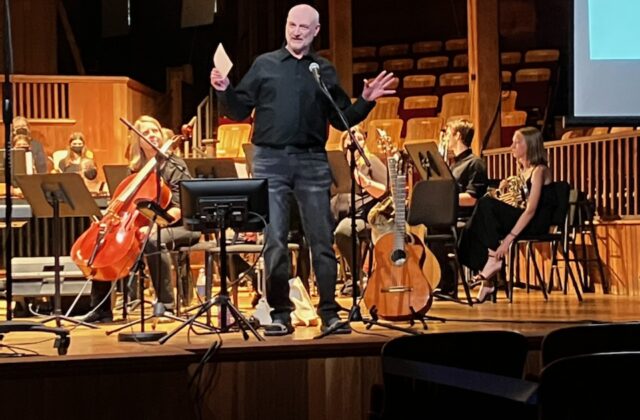Music Shed Hosts Premier of Kirk Sinclair’s American Discovery Symphony
A Musical Love Story
Text by Kelly Kandra Hughes
Photo by Heath Hughes
The world premiere of the American Discovery Symphony, an orchestrated travelogue and love story, took place on May 24 at the Music Shed in Norfolk with a socially distanced crowd of about 150 people. Approximately 37 musicians took the stage under conductor Mark Vickers, including Grammy award-winning flutist Rhonda Larson, the acclaimed Chorus Angelicus and composer Kirk Sinclair, who performed on the guitar. Not a single musician received payment; all the performances were volunteer.
The evening started off with an emotional introduction from Sinclair, who laughed that he thought he was doing pretty good since he had only cried a few times so far. He expressed heartfelt gratitude for the opportunity to perform and thanked the many people involved who helped bring the symphony to the stage, including Andrew Thomson, who served as sound engineer. Sinclair noted that Northwestern Regional High School had strong representation—from someone who was in Regional’s first band to current band members. Sinclair also thanked Ky Byrne, who drove tens of thousands of miles assisting the Sinclairs on the journey that inspired the symphony.
May 24 marked the tenth anniversary of Kirk and Cindy Sinclair’s walk of 5,000 miles across the country, over 366 days, along the American Discovery Trail (ADT). The couple met in 1980 in a group that hiked the Appalachian Trail, and throughout their marriage they maintained their passionate involvement with long-distance hiking. When several doctors could not explain the reason for Cindy’s cognitive decline in the spring of 2011, Kirk and Cindy turned to their passion in an attempt to improve Cindy’s brain health.
The American Discovery Symphony combines music, photos, interviews and sound effects to tell the story of Kirk and Cindy’s journey across the country. Beginning on May 25, 2011, the Sinclairs hiked from Point Reyes in California, through the Great Basin Desert in the summer, over the Rocky Mountains and onto the western plains in the fall, across the eastern plains in winter, and over the Appalachians toward the Atlantic Coast in spring. On reaching the official terminus of the ADT at Cape Henlopen, Del., they turned north and continued walking home to Norfolk, finishing their journey on May 24, 2012. While on the beach at Cape Henlopen, Sinclair found a pebble that he now uses as his guitar pick while playing his symphony.
The American Discovery Symphony’s five movements portray themes the Sinclairs discovered in their walk across America: Beauty, Culture, Kindness, Joy and Journey. Cindy’s brain health improved on the journey. In the beginning, she could not help with the tent or record her own journal entries. By the end, she could put up the tent by herself and write pages of entries. She would exclaim, “I feel myself getting better!” Unfortunately, Cindy’s health declined again after they returned home, prompting Kirk to observe during the performance, “There’s a point of no return with cognitive decline.”
Since then, Sinclair has been Cindy’s full-time caregiver, now in her fourth year of hospice care at home. To help preserve his own health as a caregiver, Sinclair engaged in several home projects, including the composition of his symphony. Performing the symphony seemed a natural next step, and Sinclair began recruiting friends and fellow musicians to participate. “I don’t only have a hikers’ network,” Sinclair says, “I also have a musicians’ network of sorts. Connections here and there. I asked around.” Conductor Mark Vickers, an old classmate of Kirk’s, rounded up brass musicians. Sinclair’s daughter, Serena, found other percussionists to play alongside her. It took a while to find a contra bassoon player, but Kirk eventually found one.
Now that the premiere is over, Kirk is thinking about what’s next. It’s his hope to take his symphony on the road and to travel with the pedicab that he bought for Cindy when walking became too difficult for her so that he can stop at children’s hospitals and take shut-in children out for rides.

